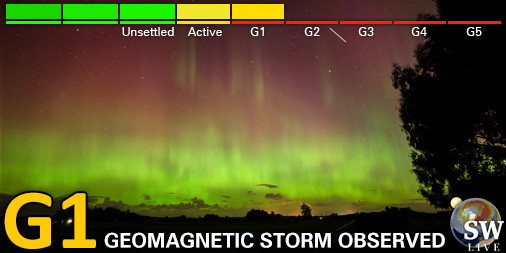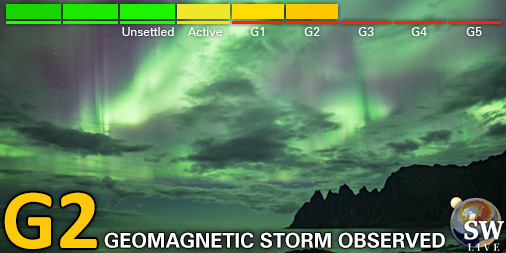Viewing archive of Friday, 22 January 2010
Solar activity report
Any mentioned solar flare in this report has a scaling factor applied by the Space Weather Prediction Center (SWPC). Because of the SWPC scaling factor, solar flares are reported as 42% smaller than for the science quality data. The scaling factor has been removed from our archived solar flare data to reflect the true physical units.
Report of Solar-Geophysical Activity 2010 Jan 22 2201 UTCPrepared by the NOAA © SWPC and processed by SpaceWeatherLive.com
Joint USAF/NOAA Report of Solar and Geophysical Activity
SDF Number 022 Issued at 2200Z on 22 Jan 2010IA. Analysis of Solar Active Regions and Activity from 21-2100Z to 22-2100Z
Solar activity has been at very low levels for the past
24 hours. Region 1041 (S25E50) produced several B-class flares, the
largest being a B9 flare at 22/1711Z. Region 1041 is stable and
classified as a Eso-beta with 7 spots. New Region 1042 (N22W28)
emerged on the disk today and is classified as a Cso-beta with 3
spots.
IB. Solar Activity Forecast
Solar activity is expected to be at
very low to low levels with a slight chance for a M-class flare.
IIA. Geophysical Activity Summary 21-2100Z to 22-2100Z
The geomagnetic field has been at quiet levels for the past 24 hours.
IIB. Geophysical Activity Forecast
The geomagnetic field is
expected to remain at quiet levels for the next three days (23-25
January).
III. Event Probabilities 23 Jan to 25 Jan
| Class M | 20% | 20% | 20% |
| Class X | 01% | 01% | 01% |
| Proton | 01% | 01% | 01% |
| PCAF | Green | ||
IV. Penticton 10.7 cm Flux
Observed 22 Jan 082 Predicted 23 Jan-25 Jan 085/085/086 90 Day Mean 22 Jan 077
V. Geomagnetic A Indices
Observed Afr/Ap 21 Jan 004/004 Estimated Afr/Ap 22 Jan 003/005 Predicted Afr/Ap 23 Jan-25 Jan 005/005-005/005-005/005
VI. Geomagnetic Activity Probabilities 23 Jan to 25 Jan
| A. Middle Latitudes | |||
|---|---|---|---|
| Active | 05% | 05% | 05% |
| Minor storm | 01% | 01% | 01% |
| Major-severe storm | 00% | 00% | 00% |
| B. High Latitudes | |||
|---|---|---|---|
| Active | 05% | 05% | 05% |
| Minor storm | 01% | 01% | 01% |
| Major-severe storm | 00% | 00% | 00% |
All times in UTC
Current data suggests there is a slight possibility for aurora to appear at the following high latitude regions in the near future
Anchorage, AK, Fairbanks, AK, Juneau, AKLatest news
Latest forum messages
Incoming & Unnumbered Active Regions 1661Unspecified geomagnetic activity 2221AR4048 114New satellites - Proba-3, PUNCH, SWFO-L1, GOES-U/19 36Filaments and prominences 750
More topicsSupport SpaceWeatherLive.com!
A lot of people come to SpaceWeatherLive to follow the Sun's activity or if there is aurora to be seen, but with more traffic comes higher server costs. Consider a donation if you enjoy SpaceWeatherLive so we can keep the website online!

Latest alerts
10:00 UTC - Hemispheric Power Index
The OVATION model predicts the Hemispheric Power Index to reach 78GW at 10:32 UTC
04:15 UTC - Geomagnetic activity
Minor G1 geomagnetic storm (Kp5) Threshold Reached: 04:05 UTC
03:15 UTC - Geomagnetic activity
Moderate G2 geomagnetic storm (Kp6) Threshold Reached: 02:59 UTC
01:00 UTC - Geomagnetic activity
Minor G1 geomagnetic storm (Kp5) Threshold Reached: 00:51 UTC
Friday, 4 April 2025
23:30 UTC - Geomagnetic activity
Minor G1 geomagnetic storm (Kp5) Threshold Reached: 23:17 UTC
Space weather facts
| Last X-flare | 2025/03/28 | X1.1 |
| Last M-flare | 2025/04/01 | M2.5 |
| Last geomagnetic storm | 2025/04/04 | Kp5+ (G1) |
| Spotless days | |
|---|---|
| Last spotless day | 2022/06/08 |
| Monthly mean Sunspot Number | |
|---|---|
| March 2025 | 134.2 -20.4 |
| April 2025 | 148 +13.8 |
| Last 30 days | 130.9 -15.2 |






